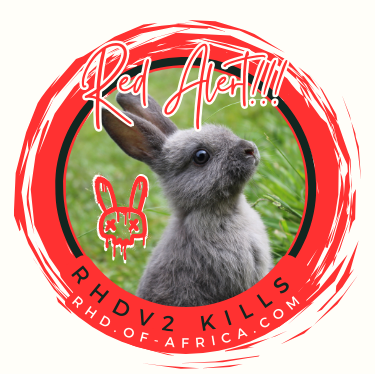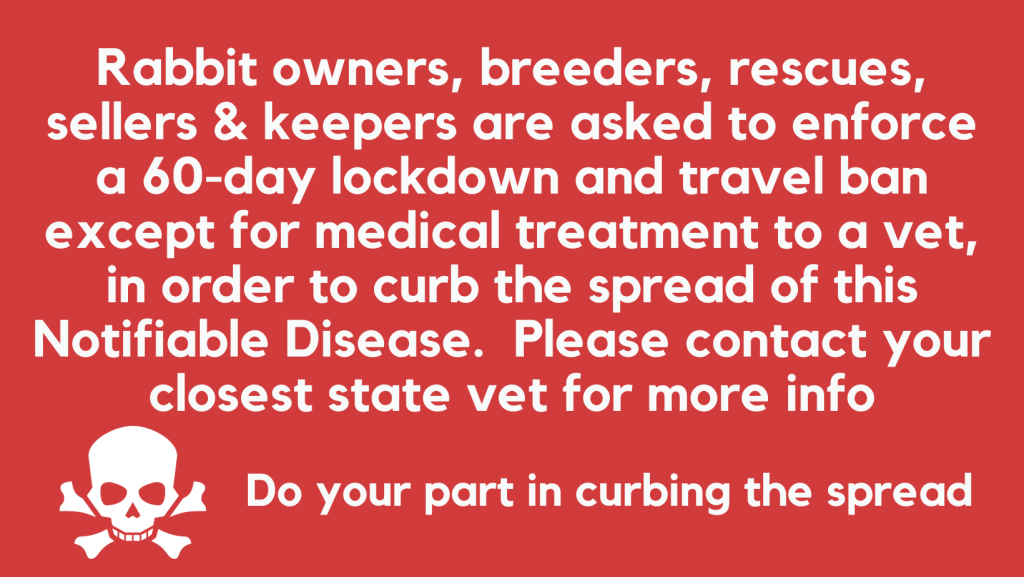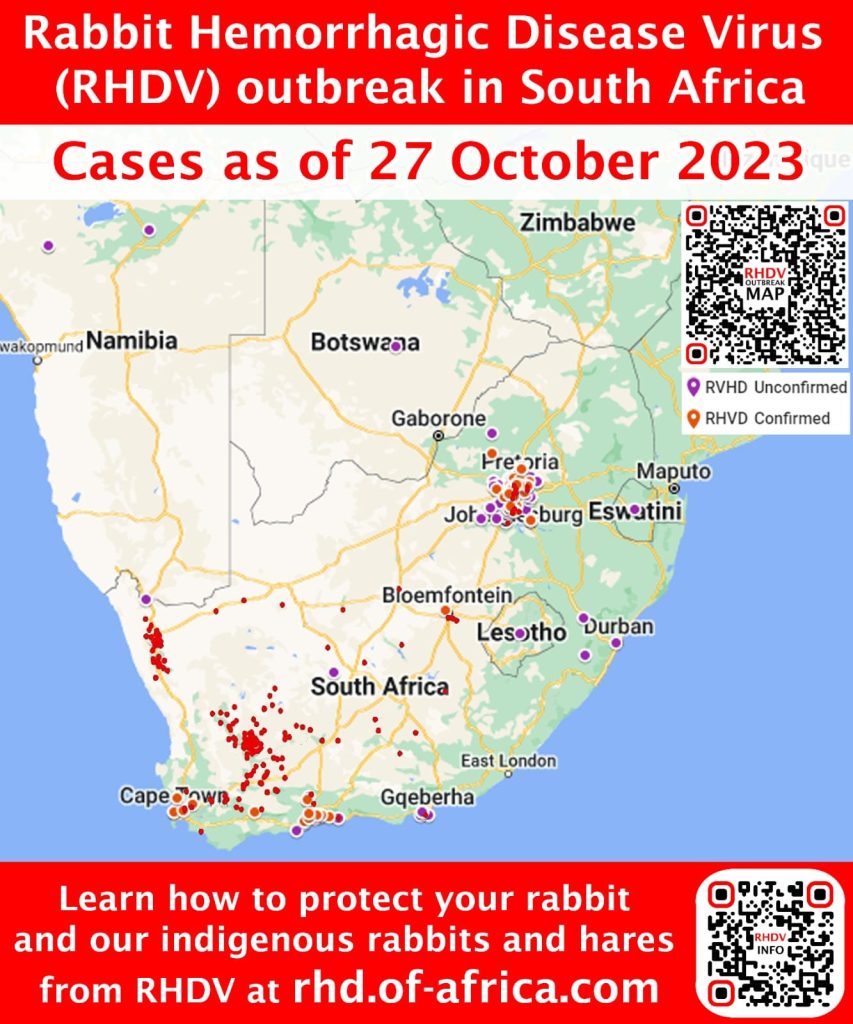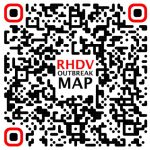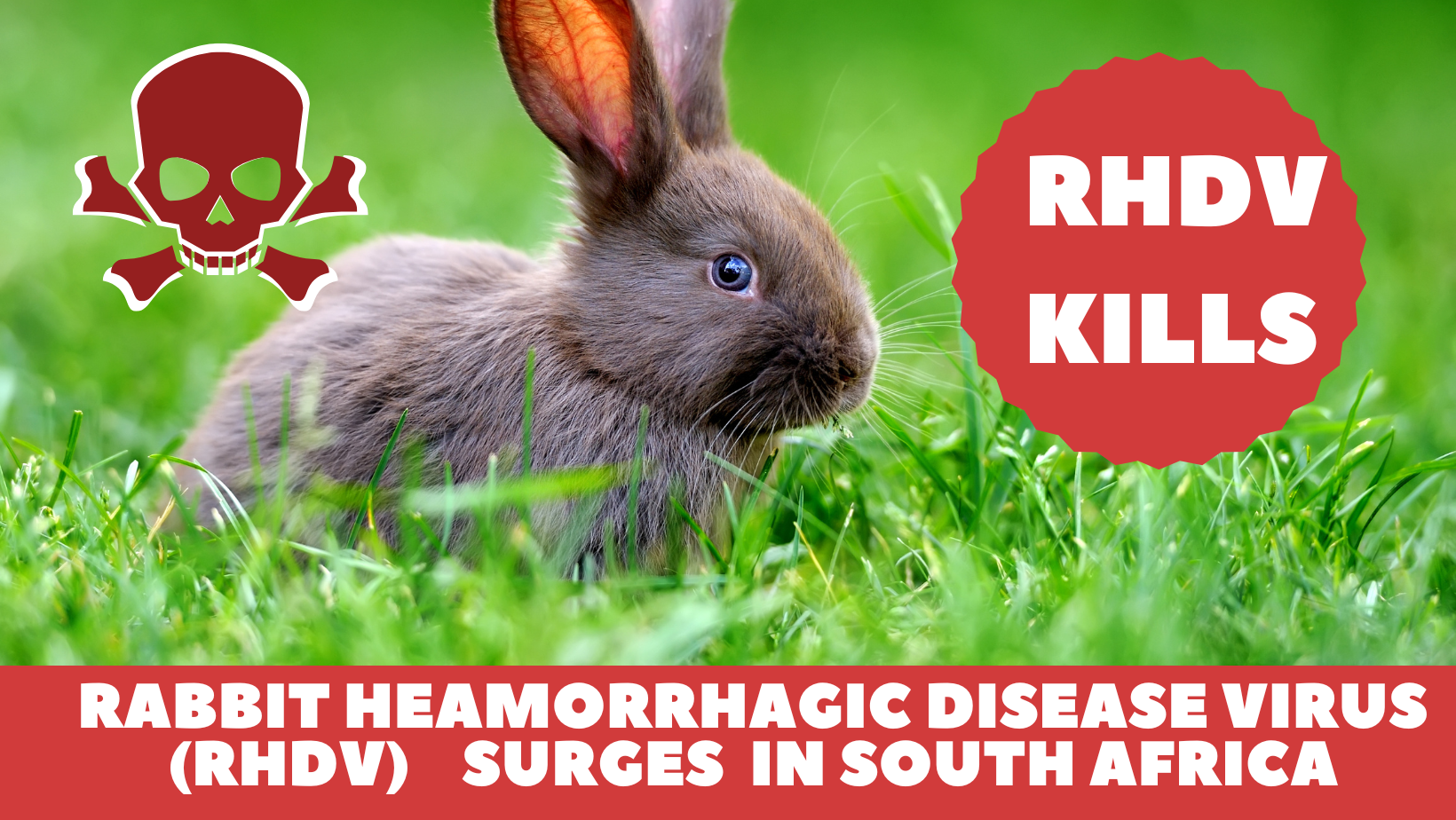
Limited Multivial Doses are available at selected vets
Please contact your vet or keep an eye on social media from vets that is know to keep the RHDV Vaccines.
We have no news on NEW Vaccines and when they will be available; if any, it may only be July 2025.
The Eravac Vaccine will e replaced, we are expecting (Unconfirmed) Yurvac that covers the different strains of RHDV2+
Current Status 5 February 2025
5 February 2025: A possible reinfection of RHD at a contained site that was previously affected. The owner of the passed rabbits has lost all excluding, and RHD Survivor that was unaffected during the previous outbreak as well. The RHD.of-Africa.com team has spoken to the extremely proactive owner, who has fully contained and is currently sterilizing and taking full measures.
There is an absolutely minimal spreading risk, as the fully educated owner has acted very efficiently, following all protocols.
This was for reporting purposes only, and is not a threat. We will again give final confirmation should we hear back from the State vet on samples.
In January 3 different cases of RHD Reports turned out to be different issues.
What the Rabbit Keeper needs to know about RHDV2
Full collaboration on information, explanation PDF written by Monique Goosen, Southern Cape Bunny Haven, and Prof Dirk Bellstedt, Dept Biochemistry, Stellenbosch University, to clear up any confusion regarding the extreme spreading of this virus and the impartance to adhere to strict protocol. Also, regarding Vaccinations and the cover that it extends towards your rabbits.

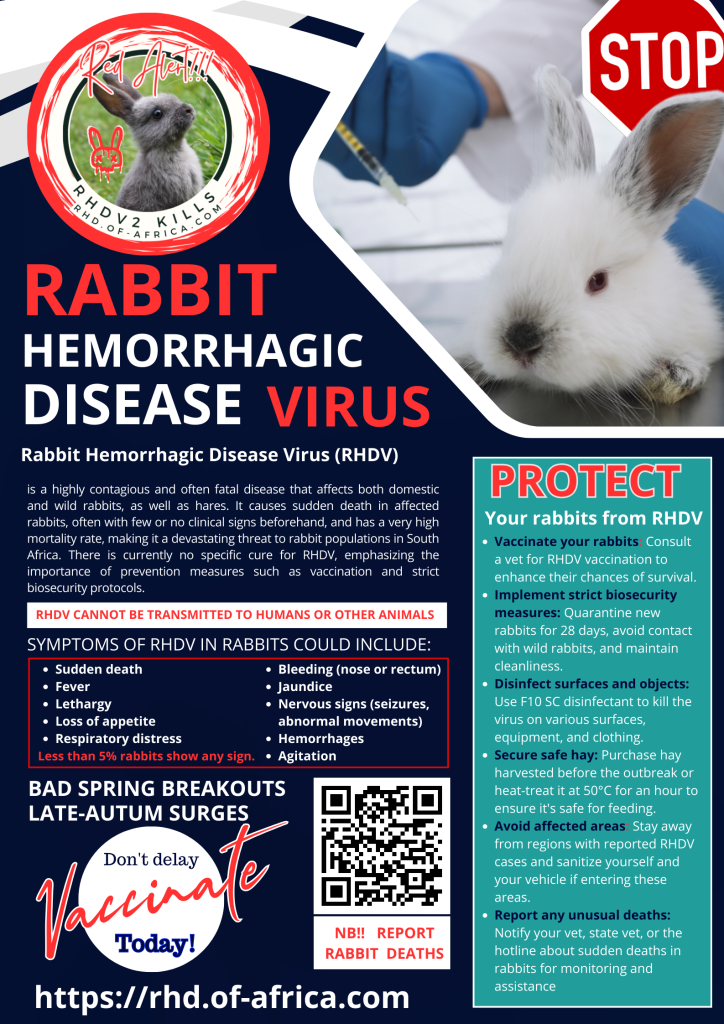
Autum Spikes; Spring Breakouts and Surges
It has been shown in patterns all over the world that Autumns create a small spike in cases as the temperatures drop, while full-blown breakouts and surges hit during springtime. This is because of the medium temperatures experienced in these seasons. Special Care should be taken to ensure that we do not experience full-blown breakouts like in 2023 when more than a third of South Africa’s Rabbits were wiped out in just 3 months.
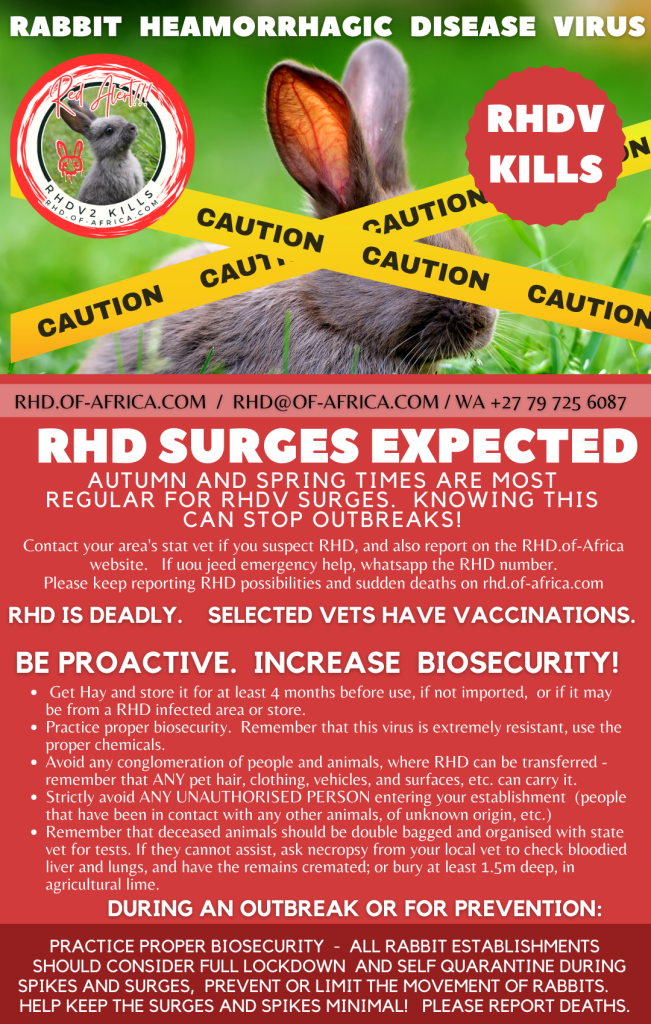
Click the button to see the current 2024 spead and cases
Vaccinated rabbits can get and still spread RHD
The Eravac Vaccine cannot give your rabbit RHD, or cause Virus Shedding, as the Vaccine is not made from live organisms. However, Your rabbit can still contract RHD during the 11 months (s)he is vaccinated for, and this can cause shedding and spreading. When your vaccinated rabbit gets into contact with any animal or human that is carrying around the virus on them, they can still get sick, and that can spread it to others even if they are not affected at all. This is why you are obliged to do full and proper biosecurity during spike and surge periods to protect your rabbits.
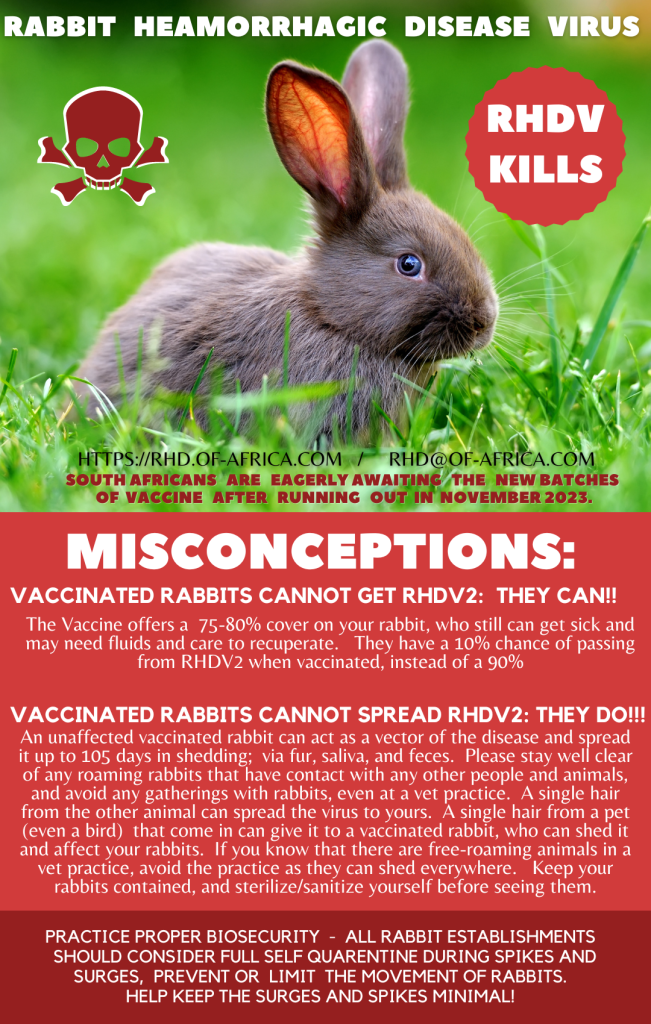
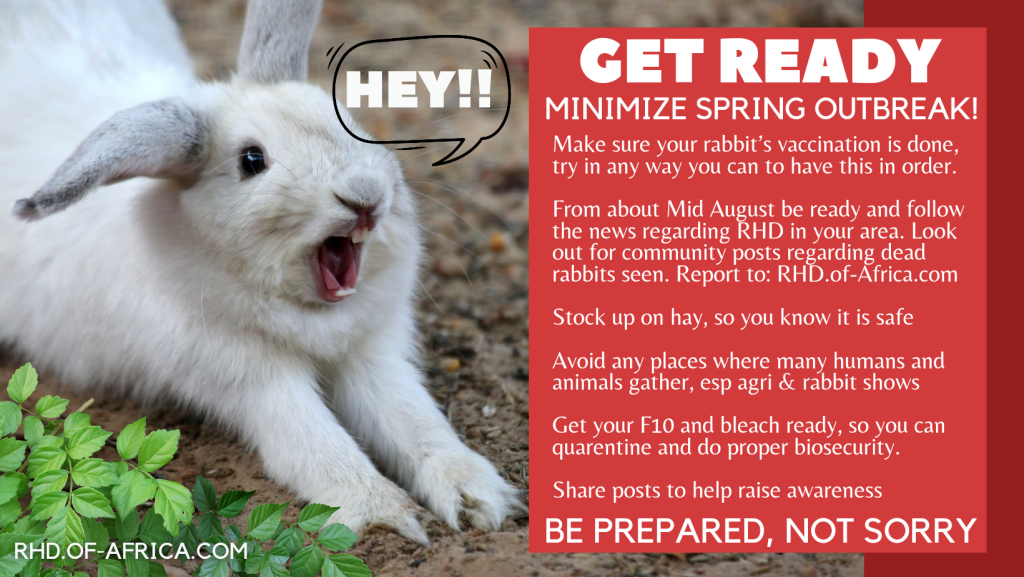
DID YOU LOOSE RABBITS IN THE PAST 6 MONTHS?
Help us understand and build the Topography Spread Map, Please!
Your data is invaluable! Please click the button and fill in the questionnaire, it takes just a few minutes.
RHDV has struck South Africa and is surging!
Rabbit Hemorrhagic Disease Virus (RHDV)
is a highly contagious and often fatal disease that
affects domestic and wild rabbits, and Hares.
South Africa has 9 Indigenous Species of lagomorphs
- Critically Endangered Riverine Rabbit
- Jameson’s Red Rock Rabbit
- Natal Red Rock Rabbit with subspecies
- Smith’s Red Rock Rabbit
- Hewwits’ Red Rock Rabbit
- Scrub Hare wih Subspecies
- Ribbuck Hare
- Cape Hare
- Savanah Hare
South Africa also have a huge population of Domesticated Rabbits non Native)
All of these species faces extinction with the rapid spread of RHDV and Nature Conservation and our government is not forthcoming in supporting the stop of RHD or even proper information spreading.
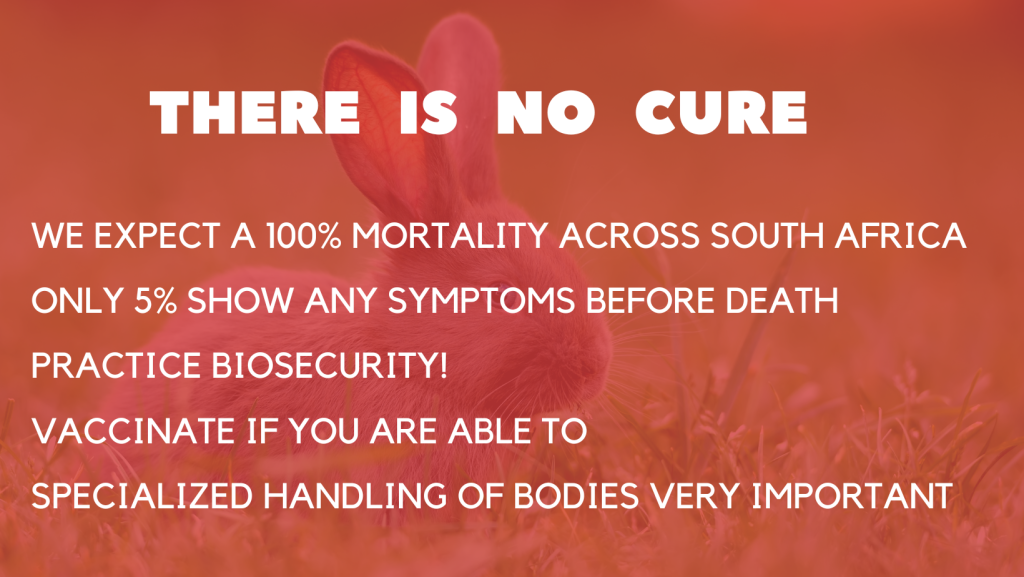
Here is some background information on RHDV:
1. Discovery and Classification:
- RHDV was first identified in China in 1984 and was originally known as “China Rabbit Calicivirus Disease” or RCV. It was later classified as a calicivirus, a type of small, single-stranded RNA virus.
- Australia released the Rabbit Hemorrhagic Disease Virus (RHDV), also known as the rabbit calicivirus, in 1995. The release was part of a biological control program aimed at managing rabbit populations, which were considered a major pest in the country. This action was taken in an effort to mitigate the environmental and economic damage caused by rabbits.
2. Types of RHDV:
- There are several strains of RHDV, including the classic RHDV (also known as RHDV1), RHDV2, and others. RHDV2 is a new variant that emerged around 2010 and can affect a wider range of rabbit species, including the European rabbit (Oryctolagus cuniculus), which is more resistant to classic RHDV.
3. Transmission:
- RHDV is highly contagious and can spread through direct contact between rabbits or via contact with contaminated materials such as food, water, bedding, and clothing. Insects like flies can also act as vectors for transmission.
4. Clinical Symptoms:
- RHDV can cause sudden death in affected rabbits, often with few or no clinical signs beforehand. Some rabbits may show signs of illness, such as fever, lethargy, loss of appetite, and respiratory distress. Bleeding from the nose or rectum may also occur.
5. Mortality Rate:
- The mortality rate for RHDV is very high, often approaching 100% in susceptible rabbit populations. The rapid progression of the disease is one of the reasons it is so devastating.
6. Impact on Wild and Domestic Rabbit Populations:
- RHDV has had significant impacts on both wild and domestic rabbit populations. In the wild, it can cause population declines and disrupt ecosystems. In domestic settings, it can lead to severe economic losses for breeders and pet owners.
7. Prevention and Control:
- There is no specific treatment for RHDV, so prevention and control measures are crucial. This can include vaccination, strict hygiene measures to prevent the spread of the virus, and quarantine procedures for new rabbits.
8. Geographic Spread:
- RHDV has spread to various parts of the world. Different strains may be more prevalent in different regions. RHDV2, for example, has been spreading in Europe, North America, and other parts of the world.
- Gauteng and Garden Route have been hot spots identified in South Africa
9. Research and Surveillance:
- Ongoing research is focused on understanding the virus, developing effective vaccines, and finding ways to control outbreaks. Surveillance efforts are also important for monitoring the spread and prevalence of RHDV.
- Please join our Hotline group in order to assist with the reports of numbers.
10. Biosecurity Measures:
- Implementing strict biosecurity measures is crucial in preventing the introduction and spread of RHDV. This includes disinfection protocols, controlling insect vectors, and minimizing contact between infected and susceptible rabbits.
- Deceased rabbits need to be burnt, or buried 1,5M+ deep with Agricultural chalk.
- Please report any sudden mass death to your nearest vet and state vet, and see to take some of the bodies in for testing. This is very important.
- Pick rabbits up using gloves and platic bags, and make sure to sterilize all before going in to any other rabbits. However, this disease can even be spread by flies, or attached to a dead rabbit’s hair or leaves blowing, as well as on hay
It’s important to note that information about RHDV may evolve over time as new research and developments occur in the field of veterinary medicine. Always consult reliable and up-to-date sources for the most current information.
Add / Request Support

RHD History in SA
Distribution History in South Africa:
The fist cases were reported from Sutherland and Springbok in September and October 2022. Cases in Oudtshoorn reported in November and December 2022.
The disease spread to Cape Town suburbs in November 22 till January 2023 and ongoing cases are still heard of, but no formal reporting.
Garden Route had their first cases in June 2023, with 2 weeks of many deaths, after which numbers became significantly less,
A huge surge has been reported in Gauteng and Garden Route, as well as other areas, since September 2023, and we at emergency levels !!!
This is actually a state of emergency as our indigenous species are also dying!
2024 had seen less cases, with many breeders afected but not reporting to state vets, due to it affecting their income. This leaded to the infections in Zamibabwe (who is also not attempting to confirm, due to financial implicaions) and Zambia
Rabbitries and Rescues alike are affected.
We urge everyone to PLEASE report any deaths.
